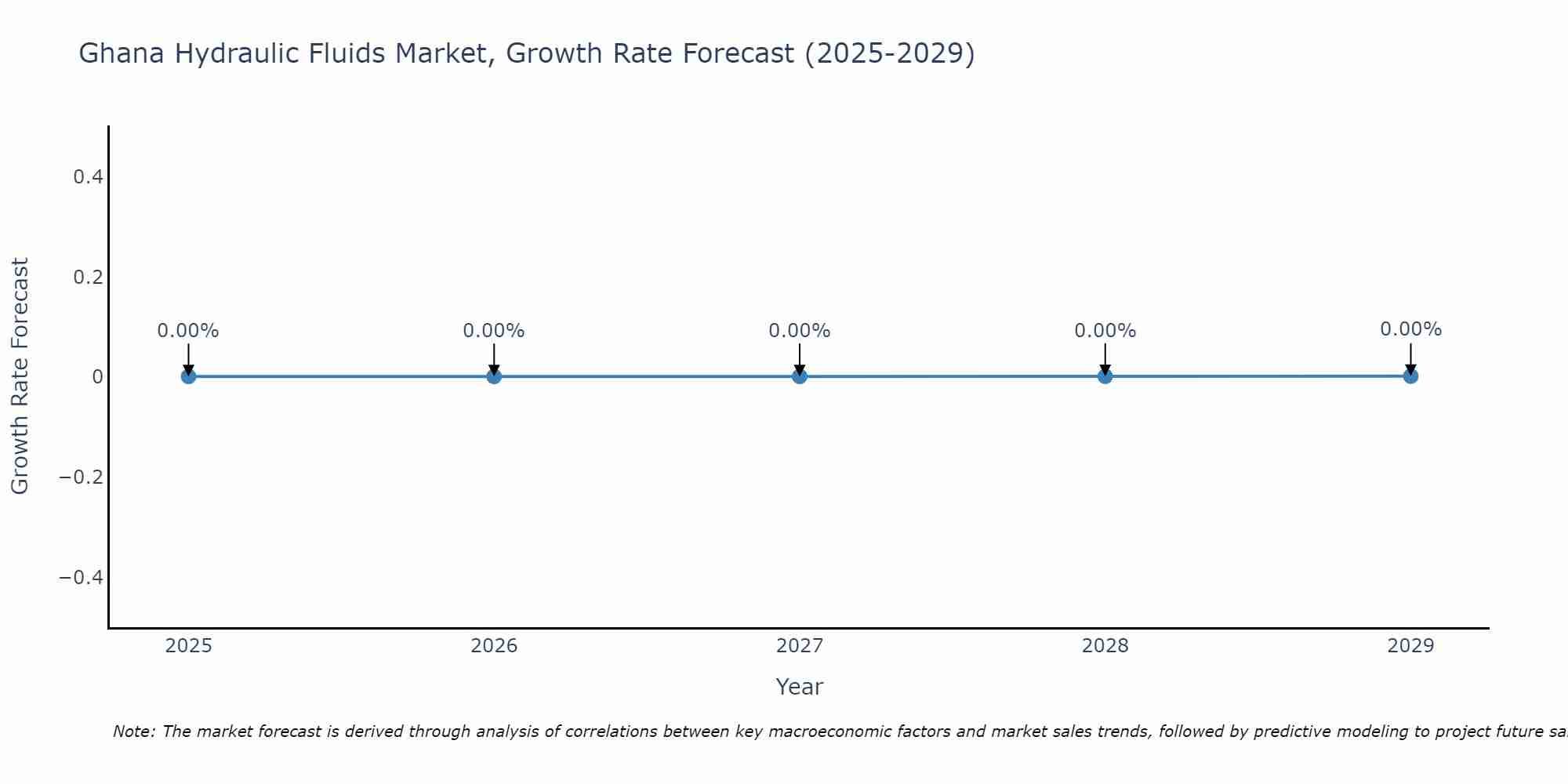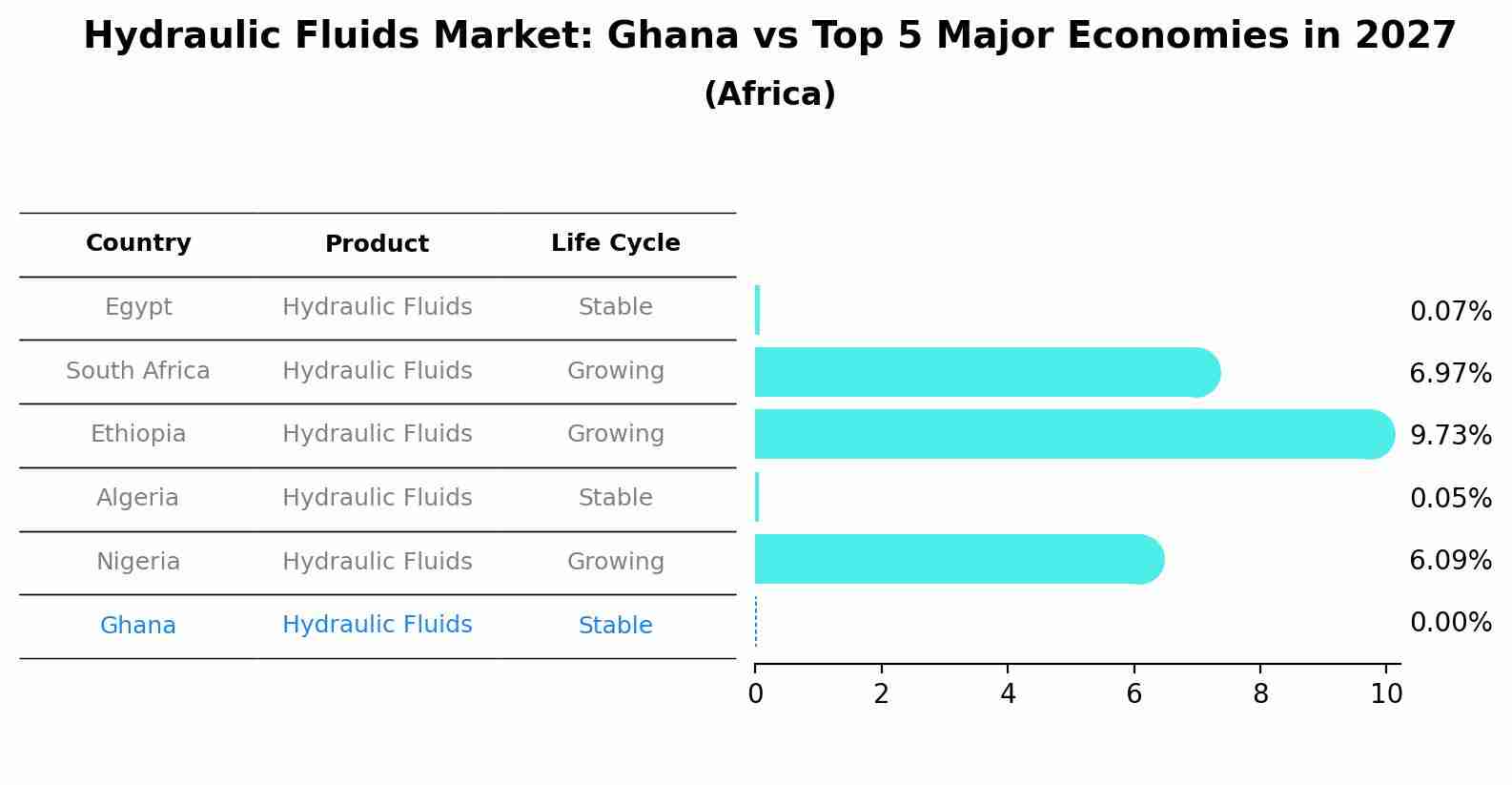Ghana Hydraulic Fluids Market (2025-2031) Outlook | Value, Trends, Growth, Companies, Revenue, Size, Forecast, Industry, Share & Analysis
| Product Code: ETC328556 | Publication Date: Aug 2022 | Updated Date: Aug 2025 | Product Type: Market Research Report | |
| Publisher: 6Wresearch | Author: Shubham Padhi | No. of Pages: 75 | No. of Figures: 35 | No. of Tables: 20 |
Ghana Hydraulic Fluids Market Size Growth Rate
The Ghana Hydraulic Fluids Market is likely to experience consistent growth rate gains over the period 2025 to 2029. Commencing at 0.00% in 2025, growth builds up to 0.00% by 2029.

Hydraulic Fluids Market: Ghana vs Top 5 Major Economies in 2027 (Africa)
The Hydraulic Fluids market in Ghana is projected to grow at a stable growth rate of 0.00% by 2027, within the Africa region led by Egypt, along with other countries like South Africa, Ethiopia, Algeria and Nigeria, collectively shaping a dynamic and evolving market environment driven by innovation and increasing adoption of emerging technologies.

Ghana Hydraulic Fluids Market Overview
The Ghana hydraulic fluid market refers to the sale and utilization of fluids designed for transmitting power and lubricating hydraulic systems in machinery, equipment, and vehicles. In Ghana, hydraulic fluids provide viscosity, lubrication, and cooling properties for hydraulic systems used in construction, agriculture, mining, and manufacturing applications, driving demand for high-performance fluids that meet industry standards and equipment requirements for optimal performance and longevity.
Drivers of the market
The Ghana hydraulic fluids market is witnessing growth driven by the expanding industrial sector, particularly in construction, manufacturing, and mining activities. Hydraulic fluids play a crucial role in hydraulic systems, providing lubrication, heat transfer, and power transmission for various machinery and equipment. Factors such as infrastructure development projects, increasing mechanization, and maintenance requirements are driving the demand for hydraulic fluids in Ghana. Moreover, advancements in fluid technology, environmental regulations, and equipment efficiency are further shaping market growth and product innovation in the country.
Challenges of the market
Challenges in the Ghana hydraulic fluids market may include addressing the specific performance requirements of different hydraulic systems and equipment while maintaining compatibility with existing fluids. Additionally, ensuring proper fluid viscosity and temperature stability under varying operating conditions could pose challenges for fluid manufacturers. Moreover, addressing concerns regarding fluid leakage, seal compatibility, and system efficiency may impact market acceptance and adoption rates.
Government Policy of the market
Given its applications in hydraulic systems for machinery, equipment, and vehicles, hydraulic fluid is subject to regulations and standards to ensure system performance, reliability, and environmental sustainability. The government of Ghana has implemented policies to regulate the production, importation, and use of hydraulic fluids, including quality specifications, labeling requirements, and environmental impact assessments to minimize pollution and contamination risks associated with hydraulic fluid usage.
Key Highlights of the Report:
- Ghana Hydraulic Fluids Market Outlook
- Market Size of Ghana Hydraulic Fluids Market, 2024
- Forecast of Ghana Hydraulic Fluids Market, 2031
- Historical Data and Forecast of Ghana Hydraulic Fluids Revenues & Volume for the Period 2021-2031
- Ghana Hydraulic Fluids Market Trend Evolution
- Ghana Hydraulic Fluids Market Drivers and Challenges
- Ghana Hydraulic Fluids Price Trends
- Ghana Hydraulic Fluids Porter's Five Forces
- Ghana Hydraulic Fluids Industry Life Cycle
- Historical Data and Forecast of Ghana Hydraulic Fluids Market Revenues & Volume By Base Oil for the Period 2021-2031
- Historical Data and Forecast of Ghana Hydraulic Fluids Market Revenues & Volume By Synthetic Oil for the Period 2021-2031
- Historical Data and Forecast of Ghana Hydraulic Fluids Market Revenues & Volume By Mineral Oil for the Period 2021-2031
- Historical Data and Forecast of Ghana Hydraulic Fluids Market Revenues & Volume By Bio-based Oil for the Period 2021-2031
- Historical Data and Forecast of Ghana Hydraulic Fluids Market Revenues & Volume By End Use for the Period 2021-2031
- Historical Data and Forecast of Ghana Hydraulic Fluids Market Revenues & Volume By Oil & Gas for the Period 2021-2031
- Historical Data and Forecast of Ghana Hydraulic Fluids Market Revenues & Volume By Marine for the Period 2021-2031
- Historical Data and Forecast of Ghana Hydraulic Fluids Market Revenues & Volume By Automotive for the Period 2021-2031
- Historical Data and Forecast of Ghana Hydraulic Fluids Market Revenues & Volume By Aerospace & Defense for the Period 2021-2031
- Historical Data and Forecast of Ghana Hydraulic Fluids Market Revenues & Volume By Construction for the Period 2021-2031
- Historical Data and Forecast of Ghana Hydraulic Fluids Market Revenues & Volume By Others for the Period 2021-2031
- Ghana Hydraulic Fluids Import Export Trade Statistics
- Market Opportunity Assessment By Base Oil
- Market Opportunity Assessment By End Use
- Ghana Hydraulic Fluids Top Companies Market Share
- Ghana Hydraulic Fluids Competitive Benchmarking By Technical and Operational Parameters
- Ghana Hydraulic Fluids Company Profiles
- Ghana Hydraulic Fluids Key Strategic Recommendations
Frequently Asked Questions About the Market Study (FAQs):
1 Executive Summary |
2 Introduction |
2.1 Key Highlights of the Report |
2.2 Report Description |
2.3 Market Scope & Segmentation |
2.4 Research Methodology |
2.5 Assumptions |
3 Ghana Hydraulic Fluids Market Overview |
3.1 Ghana Country Macro Economic Indicators |
3.2 Ghana Hydraulic Fluids Market Revenues & Volume, 2021 & 2031F |
3.3 Ghana Hydraulic Fluids Market - Industry Life Cycle |
3.4 Ghana Hydraulic Fluids Market - Porter's Five Forces |
3.5 Ghana Hydraulic Fluids Market Revenues & Volume Share, By Base Oil, 2021 & 2031F |
3.6 Ghana Hydraulic Fluids Market Revenues & Volume Share, By End Use, 2021 & 2031F |
4 Ghana Hydraulic Fluids Market Dynamics |
4.1 Impact Analysis |
4.2 Market Drivers |
4.2.1 Increasing industrialization and infrastructure development in Ghana leading to higher demand for hydraulic fluids. |
4.2.2 Growing adoption of hydraulic equipment in various sectors such as construction, mining, and agriculture. |
4.2.3 Government initiatives to promote manufacturing and industrial growth in the country. |
4.3 Market Restraints |
4.3.1 Fluctuating prices of raw materials used in hydraulic fluids production. |
4.3.2 Lack of awareness about the benefits of using high-quality hydraulic fluids among end-users. |
4.3.3 Environmental concerns related to the disposal and leakage of hydraulic fluids. |
5 Ghana Hydraulic Fluids Market Trends |
6 Ghana Hydraulic Fluids Market, By Types |
6.1 Ghana Hydraulic Fluids Market, By Base Oil |
6.1.1 Overview and Analysis |
6.1.2 Ghana Hydraulic Fluids Market Revenues & Volume, By Base Oil, 2021-2031F |
6.1.3 Ghana Hydraulic Fluids Market Revenues & Volume, By Synthetic Oil, 2021-2031F |
6.1.4 Ghana Hydraulic Fluids Market Revenues & Volume, By Mineral Oil, 2021-2031F |
6.1.5 Ghana Hydraulic Fluids Market Revenues & Volume, By Bio-based Oil, 2021-2031F |
6.2 Ghana Hydraulic Fluids Market, By End Use |
6.2.1 Overview and Analysis |
6.2.2 Ghana Hydraulic Fluids Market Revenues & Volume, By Oil & Gas, 2021-2031F |
6.2.3 Ghana Hydraulic Fluids Market Revenues & Volume, By Marine, 2021-2031F |
6.2.4 Ghana Hydraulic Fluids Market Revenues & Volume, By Automotive, 2021-2031F |
6.2.5 Ghana Hydraulic Fluids Market Revenues & Volume, By Aerospace & Defense, 2021-2031F |
6.2.6 Ghana Hydraulic Fluids Market Revenues & Volume, By Construction, 2021-2031F |
6.2.7 Ghana Hydraulic Fluids Market Revenues & Volume, By Others, 2021-2031F |
7 Ghana Hydraulic Fluids Market Import-Export Trade Statistics |
7.1 Ghana Hydraulic Fluids Market Export to Major Countries |
7.2 Ghana Hydraulic Fluids Market Imports from Major Countries |
8 Ghana Hydraulic Fluids Market Key Performance Indicators |
8.1 Number of new hydraulic equipment installations in key industries. |
8.2 Adoption rate of advanced hydraulic fluid technologies in Ghana. |
8.3 Number of training programs conducted to educate users on the importance of proper hydraulic fluid maintenance. |
8.4 Environmental impact assessment reports on hydraulic fluid disposal practices in the country. |
9 Ghana Hydraulic Fluids Market - Opportunity Assessment |
9.1 Ghana Hydraulic Fluids Market Opportunity Assessment, By Base Oil, 2021 & 2031F |
9.2 Ghana Hydraulic Fluids Market Opportunity Assessment, By End Use, 2021 & 2031F |
10 Ghana Hydraulic Fluids Market - Competitive Landscape |
10.1 Ghana Hydraulic Fluids Market Revenue Share, By Companies, 2024 |
10.2 Ghana Hydraulic Fluids Market Competitive Benchmarking, By Operating and Technical Parameters |
11 Company Profiles |
12 Recommendations |
13 Disclaimer |
- Single User License$ 1,995
- Department License$ 2,400
- Site License$ 3,120
- Global License$ 3,795
Search
Thought Leadership and Analyst Meet
Our Clients
Related Reports
- Afghanistan Apparel Market (2026-2032) | Growth, Outlook, Industry, Segmentation, Forecast, Size, Companies, Trends, Value, Share, Analysis & Revenue
- Canada Oil and Gas Market (2026-2032) | Share, Segmentation, Value, Industry, Trends, Forecast, Analysis, Size & Revenue, Growth, Competitive Landscape, Outlook, Companies
- Germany Breakfast Food Market (2026-2032) | Industry, Share, Growth, Size, Companies, Value, Analysis, Revenue, Trends, Forecast & Outlook
- Australia Briquette Market (2025-2031) | Growth, Size, Revenue, Forecast, Analysis, Trends, Value, Share, Industry & Companies
- Vietnam System Integrator Market (2025-2031) | Size, Companies, Analysis, Industry, Value, Forecast, Growth, Trends, Revenue & Share
- ASEAN and Thailand Brain Health Supplements Market (2025-2031) | Strategy, Consumer Insights, Analysis, Investment Trends, Opportunities, Growth, Size, Share, Industry, Revenue, Segments, Value, Segmentation, Supply, Forecast, Restraints, Outlook, Competition, Drivers, Trends, Demand, Pricing Analysis, Competitive, Strategic Insights, Companies, Challenges
- ASEAN Bearings Market (2025-2031) | Strategy, Consumer Insights, Analysis, Investment Trends, Opportunities, Growth, Size, Share, Industry, Revenue, Segments, Value, Segmentation, Supply, Forecast, Restraints, Outlook, Competition, Drivers, Trends, Demand, Pricing Analysis, Competitive, Strategic Insights, Companies, Challenges
- Europe Flooring Market (2025-2031) | Outlook, Share, Industry, Trends, Forecast, Companies, Revenue, Size, Analysis, Growth & Value
- Saudi Arabia Manlift Market (2025-2031) | Outlook, Size, Growth, Trends, Companies, Industry, Revenue, Value, Share, Forecast & Analysis
- Uganda Excavator, Crane, and Wheel Loaders Market (2025-2031) | Strategy, Consumer Insights, Analysis, Investment Trends, Opportunities, Growth, Size, Share, Industry, Revenue, Segments, Value, Segmentation, Supply, Forecast, Restraints, Outlook, Competition, Drivers, Trends, Demand, Pricing Analysis, Competitive, Strategic Insights, Companies, Challenges
Industry Events and Analyst Meet
Whitepaper
- Middle East & Africa Commercial Security Market Click here to view more.
- Middle East & Africa Fire Safety Systems & Equipment Market Click here to view more.
- GCC Drone Market Click here to view more.
- Middle East Lighting Fixture Market Click here to view more.
- GCC Physical & Perimeter Security Market Click here to view more.
6WResearch In News
- Doha a strategic location for EV manufacturing hub: IPA Qatar
- Demand for luxury TVs surging in the GCC, says Samsung
- Empowering Growth: The Thriving Journey of Bangladesh’s Cable Industry
- Demand for luxury TVs surging in the GCC, says Samsung
- Video call with a traditional healer? Once unthinkable, it’s now common in South Africa
- Intelligent Buildings To Smooth GCC’s Path To Net Zero


















